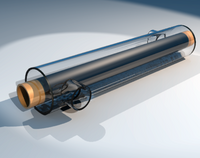
Photo from wikipedia
Abstract Turbulent-flow and heat-transfer characteristics have been numerically studied in a turbulent channel flow with different micro-fin roughnesses on the lower wall. Internally enhanced surfaces such as micro-fins are beneficial… Click to show full abstract
Abstract Turbulent-flow and heat-transfer characteristics have been numerically studied in a turbulent channel flow with different micro-fin roughnesses on the lower wall. Internally enhanced surfaces such as micro-fins are beneficial to thermal performance in commercial applications such as heat exchangers, refrigerators, chillers, and air conditioners. In contrast, the added mass of the fins to the surface leads to higher costs for bulk commercial products and also increases pressure drop. Studies of flow fields around these fins have appeared in the literature but often do not include conduction analysis in the fin, leaving a key optimization parameter unexplored. The goal of this paper is to fill this gap by finding out the effects of micro-fin design parameters on heat-transfer enhancement and pressure drop by holding the micro-fin volume constant over the numerical space. Design parameters of interest are cross-sectional profile, height, yaw angle, and pitch. A coupled numerical simulation of the turbulent flow at Reynolds number 15,000, with periodic boundaries and solid domains, was set up and validated in ANSYS Fluent and the performance was mapped. Mean-velocity profiles showed the well-known downward shift of the logarithmic portion of the law of the wall. Results showed the transverse rectangular micro-fin with pitch-to-height ratio (p/Ks) of 3.5 (corresponds to a so called d-type roughness) can enhance the performance factor by as much as 40% compared with a smooth surface. In addition, by changing the micro-fin pitch, it was found that the heat-transfer rate decreases and pressure drop increases for the transverse rectangular micro-fins with p/Ks of greater than 5 (corresponds to a k-type roughness), which demonstrated the breakdown of the Reynolds analogy.
Journal Title: International Journal of Thermal Sciences
Year Published: 2020
Link to full text (if available)
Share on Social Media: Sign Up to like & get
recommendations!